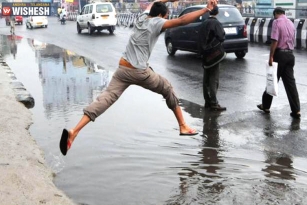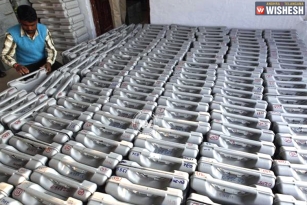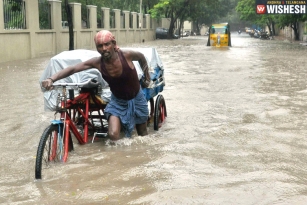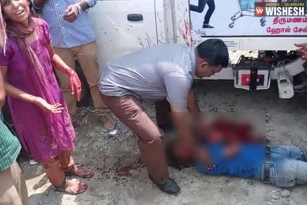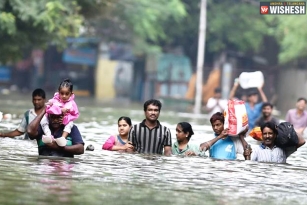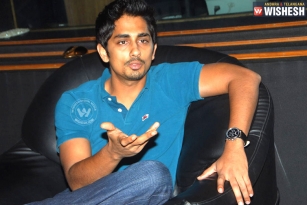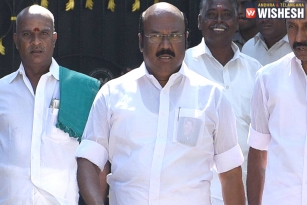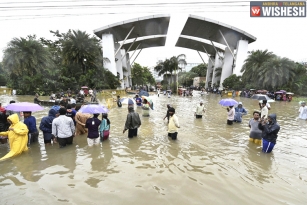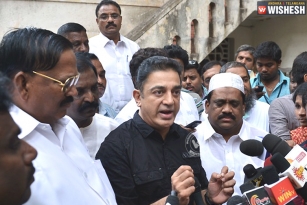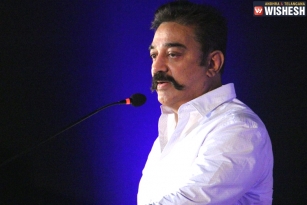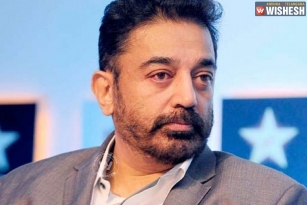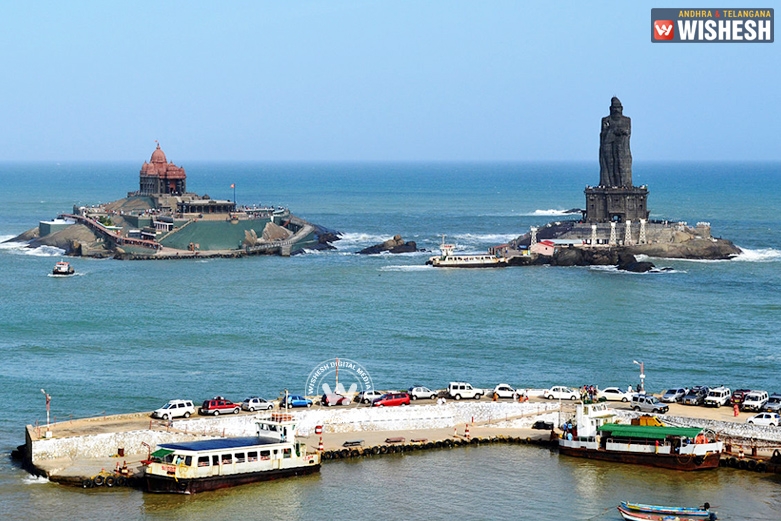
Kanyakumari is the southern most district of India in the state of Tamilnadu. Kanyakumari is situated between 77o 15' and 77o 36' of the eastern longitudes and 8o 03' and 8o 35' of the Northern Latitudes. It shares the boundary with Tirunelveli District on the North and the east, Gulf of Mannar in the South East, in the South and the South West are Indian Ocean and the Arabian Sea and in the West and North West it is bound by Thiruvananthapuram district of Kerala. Kanyakumari is the southern tip of the Cardamom Hills, an extension of the Western Ghats range through the west coast of India. Kanniyakumari is 705 kms from Chennai the capitol city of the state of Tamilnadu.
Kanyakumari is famous for its incomparable geographical location of not only it’s the land’s end of the Indian sub-continent, but also for the confluence of Three seas viz. Arabian sea, Indian Ocean and Bay of Bengal. Here, Bay of Bengal meets the Indian Ocean and Arabian Sea. A dip in the ‘Triveni Sangam’ (confluence of the three seas) is considered to be very auspicious.
How to reach
Thiruvananthapuram airport in the state of Kerala is the nearest airport, which is around 90 KM from Kanyakumari. Popular airlines alike Air India, IndiGo, Jet Airways, Qatar Airways, Etihad, Oman Air, Air Arabia and Kuwait Airways have excellent connectivity to different cities of India and other countries from this airport.
Kanyakumari is well connected with railways. The nearest major railway station is Thiruvananthapuram railway station in the state of Kerala, which is connected to almost all the major cities in India.
Kanyakumari is also well connected by road. There are many buses plying to the nearest major cities which are operated by government agencies as well as private transporters.
History
Previously Kanyakumari district was the part of the erstwhile Travancore state. In 1835, when the state was divided, this area became the part of Southern division and was placed under the jurisdiction of Dewan Peishkar of Kottayam. In July 1949, when the United States of Travancore and Cochin was formed, the present Kanniyakumari district continued to be a part of Thiruvananthapuram district of Kerala State. The people of Agasteeswarem, Thovalai, Kalkulam and Vilavancode Taluks, were predominantly Tamil speaking. They agitated for the merger of this area with Madras State. The States Reorganisation Commission also recommended this and accordingly, the States Reorganisation Act, 1956 was passed and the Kanyakumari District was formed on 1st November 1956 , with the four Taluks, Viz., Agasteeswarem, Thovalai, Kalkulam and Vilavancode and merged with Tamilnadu.
Mythology
Kanyakumari is a popular pilgrim centre and named after goddess ‘Parvati’, wife of lord ‘Shiva’. ‘Kumari Amman’ a temple is dedicated to virgin goddess Kanyakumari (kanya – ‘lady’, kumari – ‘virgin’). Kanyakumari has great spiritual significance for Hindus. It’s dedicated to the goddess Devi Kanya, an incarnation of Parvati. Pilgrims come here to visit the Kanyakumari temple and bath in the Triveni sangamam.
The legend says that the Asuras got supremacy over the Devas, which led to Adharma, ignorance and injustice. Banasura, the king of demons, drove away Devas from heaven and meted out cruel punishments to saints. Due to the agony, Mother Earth sought the help of Lord Vishnu, the Protector of the Universe. The Lord advised that the Devas to pray to Parashakti, who alone is capable of destroying Banasura. Devas performed Yagna to please the Goddess, who appeared before them and promised to annihilate the evil forces. She came to Kanyakumari in the form of a Virgin girl and began her penance. Meanwhile, Lord (of nearby Suchindram temple) fell in love with her and arrangements were made for their marriage.
The divine sage Narad realized that this marriage will destroy the chances of annihilating Banasura, because it was pre-ordinated by Brahma that the demon king could be killed only by a Virgin. Narad decided to stop this marriage. He met both Goddess, Kanya and Lord Shiva and asked them to be ready for the marriage, which has to take place at an auspicious hour at midnight. On the date of marriage Lord Shiva started from Suchindram to Kanyakumari, for the marriage at the auspicious time without missing it. As the Lord reached Vazukkamparai, five kilometers south of Suchindram, Narada assumed the form of a cock and crowed falsely, heralding the break of dawn. Thinking that the auspicious hour for this marriage was over, Lord returned to Suchindram. The Goddess decided to remain Virgin ever after. All the food items prepared for the divine wedding were turned into sand. Small pebbles, resembling rice and the multi-coloured sands are found abundantly on the shore, are believe to be attributed to the above incident.
Bansura heard about the beauty of the Virgin Goddess and requested her hand in marriage. When the Goddess spurned the idea, the demon king decided to win her by force. A fierce battle ensued that the Goddess killed the demon with her Chakrayudha. This relieved Devas and they expressed their gratitude to the Goddess and returned blessed.
Places to visit
Kanyakumari Temple: The legend of this temple is related to the above mythology. The temple is dedicated to the virgin goddess Kanniyakumari, Parvati who stands guard over the country, the temple is built at the spot where the goddess is believed to have waited for her consort Lord Shiva to come and claim her hand in marriage.
Vivekananda Memorial: This was built on the Vivekananda Rock where Swami Vivekananda meditated and transformed himself. The unique, structure was built in 1970 by the Vivekananda Rock Memorial Trust and is a blend of various Indian architectural styles.
Thiruvalluvar Statue: Thiruvalluvar, is the author of the Thirukkural. Thirukkural is regarded as a renowned work, eulogised as a directory of the code of conduct and ethics to humanity. Through 1330 couplets, the revered poet deals with the general administration and codified and gave clear-cut directions to mankind on how they should behave and act in a social, political, religious and family circles.
Gandhi Memorial: Gandhi Mandapam has been constructed at the spot where the ashes of Mahatma Gandhi were kept in an urn for public view before a portion of it was immersed into the confluence of the three seas, Triveni sangamam, in 1948. Every year on Gandhiji's birthday, the 2nd October, the sun's rays falls on the exact spot where the urn was displayed before immersion.
Government Museum: The Museum contains bronzes, coins, tribal objects, wood carvings and zoological and botanical specimens, Temple Car made from Samythoppu and whale bones from Manavalakurichi in Kanniyakumari District.
Vattakottai or the Circular Fort: A granite fort, which is situated around 6 KM northeast of Kanniyakumari, forms the terminal of the ramparts known as the South Travancore lines built by Travancore King Marthanda Varma.
Suchindram: The Suchindram Sthanumalayan temple is situated around 13 KM from Kanyakumari and is dedicated to Lord Shiva, Lord Vishnu and Lord Brahma. There are musical pillars and a huge 18-ft high Hanuman statue as the proof of the artistic skill of the 9th Century A.D. artisans. There is also a unique bas-relief carving of Vinayaki or the Female Vinayaka.
Udayagiri Fort: This is situated around 34 KM from Kanyakumari. King Marthanda Varma built this fort in the 18th century. The most trusted general of the king, the Dutch General De Lennoy’s grave lies within the fort.
Padamanabhapuram Palace: Padmanapuram or the City of Lord Vishnu is an ancient historical town which is situated around 45 KM from Kanniyakumari. Padmanapuram was an ancient Capital of the Travancore rulers until 1798 A.D. The palace is spread over an area of 6 acres. The palace is known for its antiques, including the armoury of the royal family.
Chidaral: Chitharal is a small village situated at a distance 55 KM from Kanniyakumari. Chitharal has a cave containing rock-cut sculptures of Thirthankaras and attendant deities carved inside and outside dating back to the 9th century A.D.
Thiruvattar: Thiruvattar is situated around 46 KM from Kanyakumari The temple is dedicated to Adi Kesava Perumal in the Ananthasayanam posture and is considered one of the 13 sacred places for the Vaishnavites. This temple fixes dated to the 12th century. Old mural paintings belonging to the 17th century can be seen on the walls of the inner shrine. Woodcarvings show exquisite workmanship and they adorn some of the structures in the temple.
By Premji














